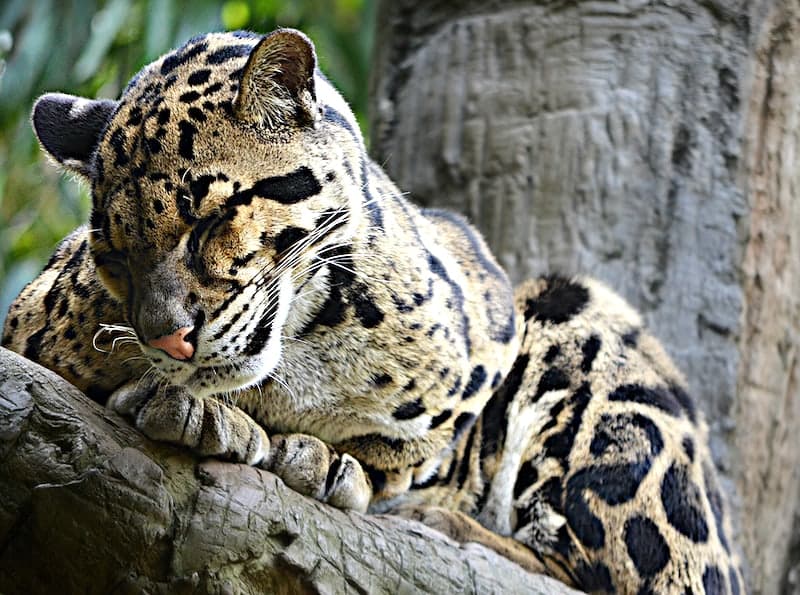It is true that Cambodia does not have lions but there are many other wild cats out there in the wild. The thing is that many Cambodian people also don’t know what wild cats they have in their country. This is why the list below is going to be useful if you want to know about wild cats in Cambodia. Let’s take a look and see how many of them that you know of.
Asiatic Golden Cat
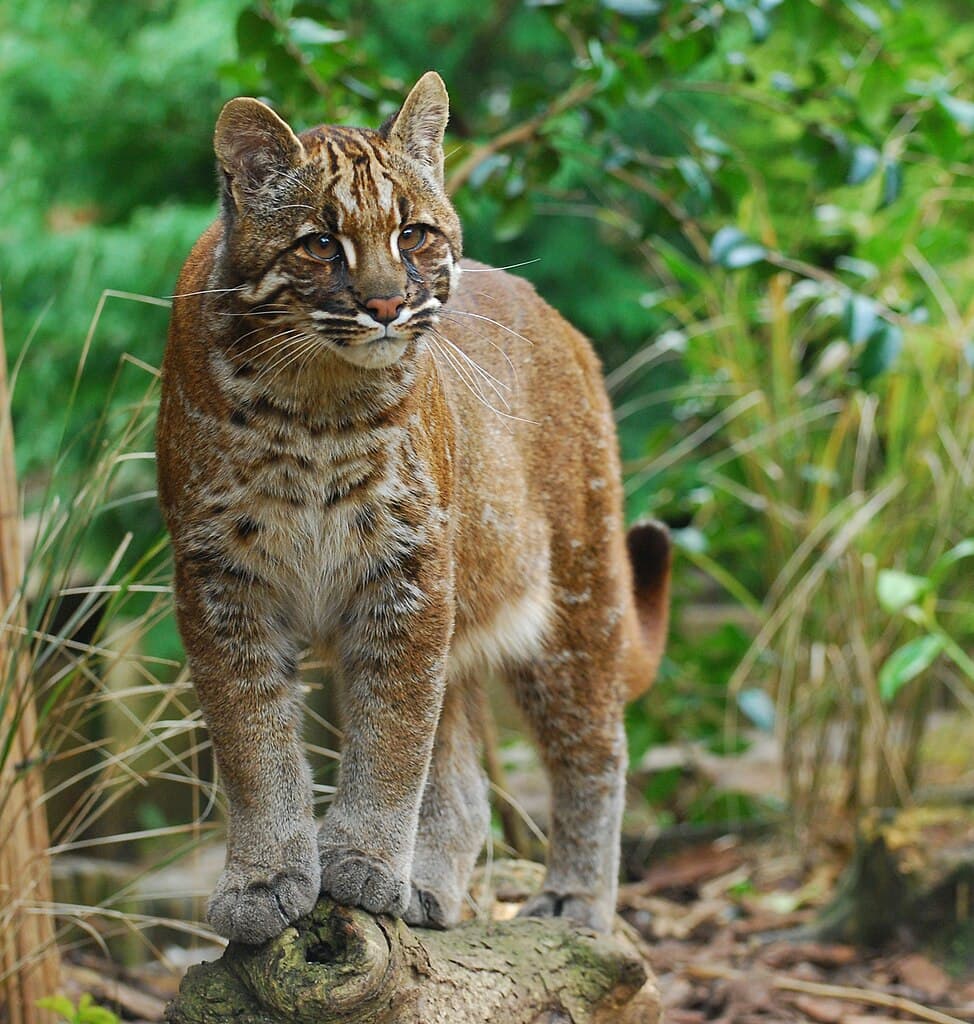
Asiatic golden cat (ខ្លាលឿងមាស) is one of the rare tiger species in the world that is present in Cambodia’s conservation area. When it comes to coloration, things are varied in Asiatic golden cats depending on where they are from. In Bhutan and northeastern India, these cats can be golden and reddish brown or buff brown. Meanwhile, there are reddish-brown morphs in Sumatra. There was even one spotted Asiatic golden cat with large rosettes on its shoulders, flanks, and hips. Their tail is one-half to a third of their size, and their body length is from 116 to 161 centimeters.
Asiatic golden cats inhabit dry deciduous, subtropical evergreen, and tropical rainforests but they prefer forest habitats interspersed with rocky areas. These wild cats are solitary and territorial, and they like to wander and hunt alone. Speaking of hunting, their prey includes birds, hares, reptiles, rodents, and small ungulates like muntjacs and sambar deer. With the ability to climb trees, hunting birds is not an issue. At the same time, they are also strong enough to take down larger prey such as domestic water buffalo calves as well.
This medium-sized cat species has been listed as Near Threatened on the IUCN Red List since 2008. People poach them for meat, and habitat destruction due to deforestation is also one of the reasons as well. Asiatic golden cats’ meat is considered a delicacy, and their bones are used for medicinal purposes. In local superstition, people believe that carrying a piece of their hair or burning their pelt can drive tigers away.
Fishing Cat
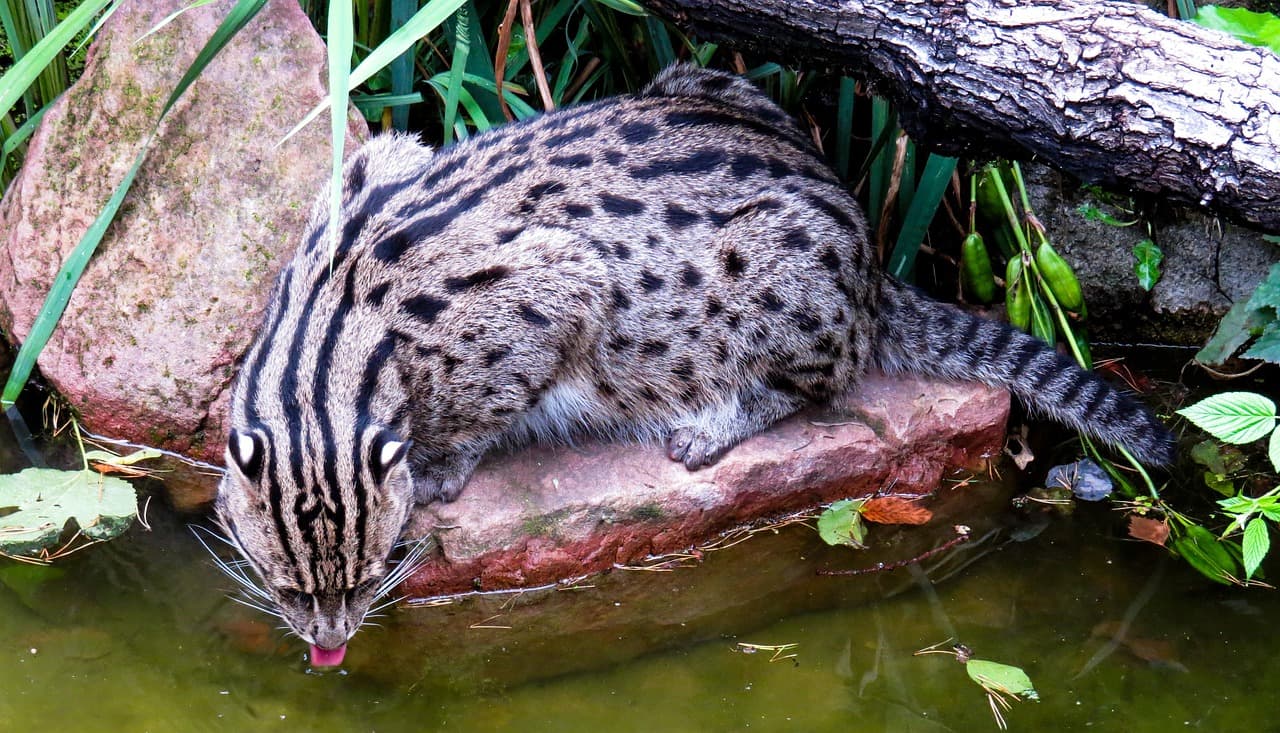
Looking like a mini cheetah, a fishing cat (ខ្លាត្រី) is one of the 8 big cats in Cambodia. It is about twice the size of a domestic cat, growing up to 78 centimeters. A fishing cat has deep yellowish-gray fur with black lines and spots. It also has two stripes on the cheeks and two above the eyes that run to the neck. These stripes give me the immediate thought of a cheetah the moment I saw them. A fishing cat also has spots on their shoulders and sides as well. While many big cats have long tails, the tail of this species is rather short; with a few black rings at the end.
Not different from the Asiatic golden cats, fishing cats also prefer wetlands. They inhabit marshy areas and swamps around mangrove forests, oxbow lakes, reed beds, and tidal creeks. Where they live, they prey on fish but also feed on birds, insects, mollusks, reptiles, and rodents. A fishing cat hunts along the edges of watercourses by grabbing prey from the water. On some occasions, they also dive into the water to catch prey as well. And since it is not too big, is it cute and cuddly? Cute, yes. Cuddly, don’t think so. Fishing cats can be very aggressive, and these cats can swim to hunt while other cats hate water. So think twice if you want to pet one.
Fishing cats have been listed as Vulnerable since 2016 because of the threats to their population. The destruction of wetlands which are their habitats has affected their number greatly. People convert wetlands for agricultural uses and human settlements, and wetland pollution also plays a part.
Clouded Leopard
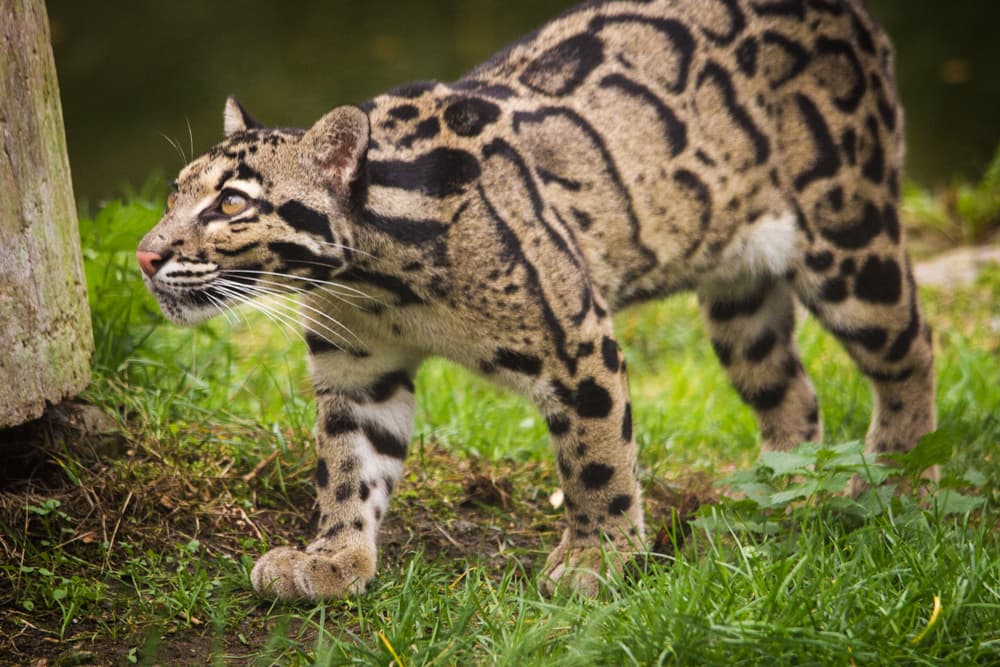
Here we have a wild cat that has a very noticeable appearance at a glance. A clouded leopard (ខ្លាពពក) can grow from 68.6 to 108 centimeters, and its tail can be up to 91 centimeters. This long tail allows them to balance when they move in trees and climb down vertical tree trunks head first. What an impressive skill, right? The body of a clouded leopard has large dusky-gray blotches along with irregular spots and stripes that look like clouds.
Clouded leopards are nocturnal, they rest in trees during the day and hunt during the night. They are arboreal, rare, and secretive, and they inhabit dense primary forests. The clouded leopards are so strong, and their long canines (2 inches) allow them to bite deep into their prey’s necks. In fact, they have the largest canine teeth (proportionate to body size) of any wild cat. As a vicious hunter, a clouded leopard stalks its prey or waits for it to approach before pouncing. The main menu consists of gibbons, macaques, porcupines, small deer, and wild boars; and sometimes birds, livestock, rodents, and squirrels.
These big cats are Vulnerable in Cambodia, and they are already locally extinct in Singapore, Taiwan, and Vietnam. The threats to their population include commercial poaching for the wildlife trade and large-scale deforestation. Their body parts (claws, skins, teeth) are used for clothing and decoration despite the fact that hunting them is illegal.
Jungle Cat
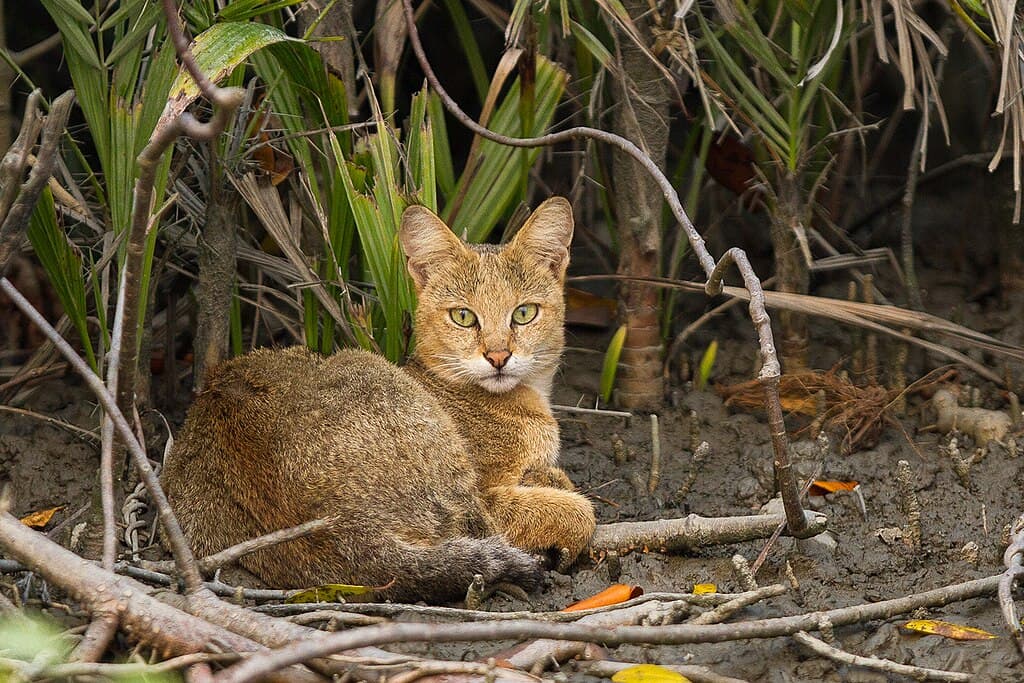
Also goes by the name jungle lynx, reed cat, and swamp cat, the jungle cat (ឆ្មាព្រៃ) is one of Cambodia’s wild cats. While all big cats above have spots or stripes, this one doesn’t. It has a sandy reddish-brown or gray fur, growing between 59 and 76 centimeters. Jungle cats have large pointy ears that can grow up to 8 centimeters, and the ears are close together. As for their legs, they are long and slender.
When it comes to habitats, they like to be in places with adequate water and dense vegetation. So they are quite common in agricultural lands, grasslands, littoral, mountains, riparian areas, shrub, and swamps. As a medium-sized cat, this predator preys on small birds and mammals that it can find. Its ears act as radar to locate the prey, allowing it to stalk before leaping or sprinting to catch the food. Speaking of food, their meals include birds, fishes, frogs, insects, small mammals (gerbils, hares, rodents), and small snakes. On top of that, they are partially omnivorous so they feed on fruits when food is not scarce in winter.
Jungle cats are solitary, but they will come together during the mating season. The interesting thing about them is that they can produce sounds like small roars when threatened. Not different from other big cats, jungle cats also face threats to their population. Habitat loss from dam construction, environmental pollution, industrialization, urbanization, and wetland destruction along with illegal hunting are the major threats. When it comes to illegal hunting, poisoning, snaring, and trapping have caused their population to decrease in many areas throughout their range.
Leopard
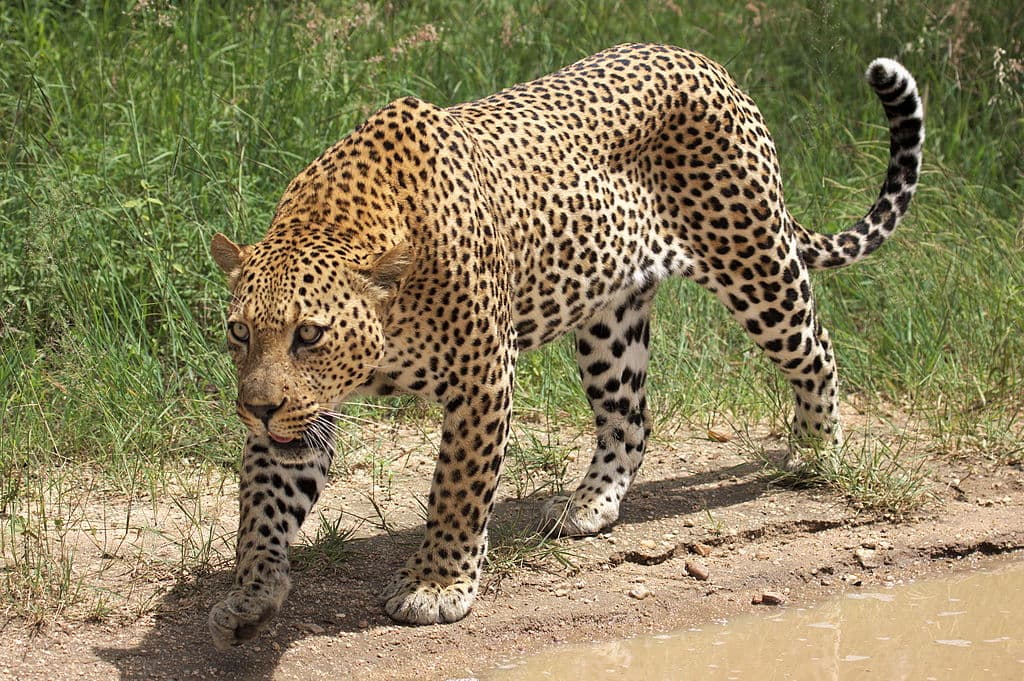
Leopards (ខ្លារខិន) are very common in the wild cat’s world, and they are very easy to recognize. A leopard has pale yellowish to dark golden fur with dark spots grouped in circular rosettes. It has a slender yet muscular body that can reach a length of 92 to 183 centimeters. The tail of a leopard can be from 66 to 102 centimeters long.
When it comes to the habitats of the leopards, there is a wide variety in that. It could be from rainforests to steppe as well as arid and montane areas. Leopards are very strong animals, and these opportunistic predators hunt primates and ungulates. Their menu consists of many things such as bat-eared fox, black-backed jackal, bushbuck, cheetah, chital, common duiker, genet, gray langurs, impala, and white-eyelid mangabeys. They primarily hunt at night, and they use their acute senses of hearing and vision to detect prey. Leopards are notorious for their strength to drag large animal prey up to tree branches, not something every big cat can do. At the same time, they are strong swimmers so they also feed on crabs or fish.
Leopards are one of the African “Big Five” among sports hunters, and trophy hunting has severely affected their population. In many places, locals consider leopards as pests to farms and livestock so they persecute leopards for meat and fur. At least the good thing is that their population is stable throughout their natural range.
Leopard Cat
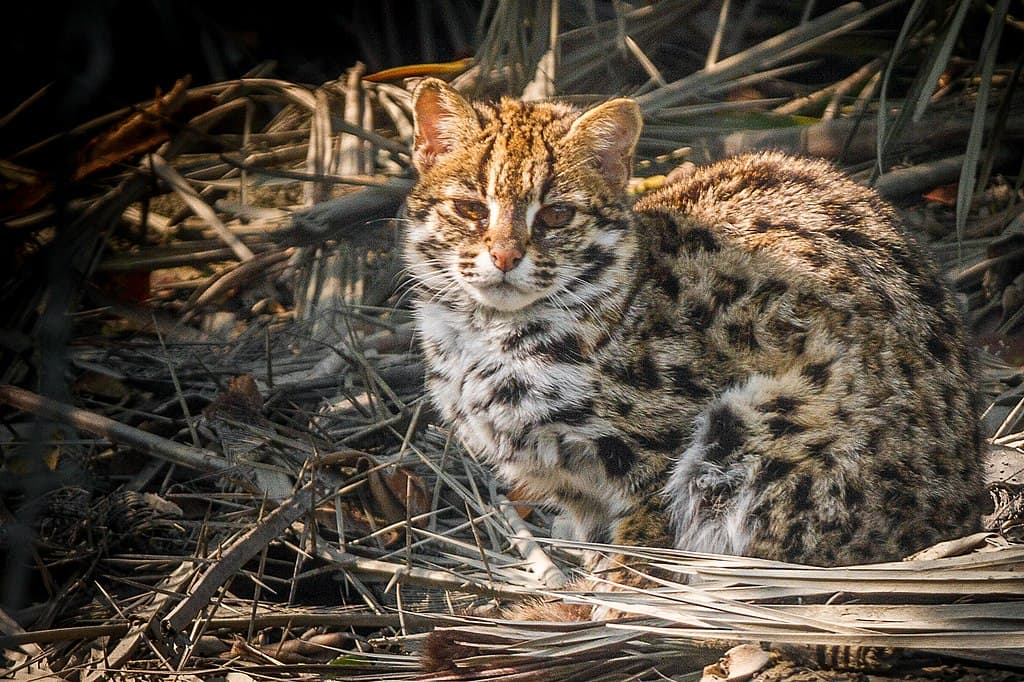
A leopard cat (ឆ្មាដាវ) has the size of a domestic cat but is slender, and it has longer legs with toe webs. One of the things that you can easily notice about leopard cats is the two prominent dark stripes on their small head. You can also see the other two dark stripes running from their eyes to their eyes as well. The coloration of these wild cats is varied, but the background color of the spotted fur is usually tawny. However, these felines often have orange or yellow fur with distinct spots similar to those of leopards.
These small wild cats live in a wide variety of habitats throughout their range. Leopard cats live in plantations and tropical evergreen rainforests at sea level along with coniferous forests and subtropical deciduous. Not different from many wild cats in Cambodia out there, leopard cats are also solitary. Some of them are active during the day but most of them hunt at night. Their agile climbing skill allows them to be great arboreal hunters, stalking hares, murids, tree shrews, etc. At the same time, they also feed on amphibians, birds, insects, lizards, and small mammals.
In China, people hunt leopard cats for their fur while other areas also hunt them for meat and pet trade. Other main threats include getting caught in snares set for other species, habitat loss, heavy commercial exploitation, commercial fur trade, etc. The good thing is that their population is still doing well in the wild throughout their native range.
Marbled Cat
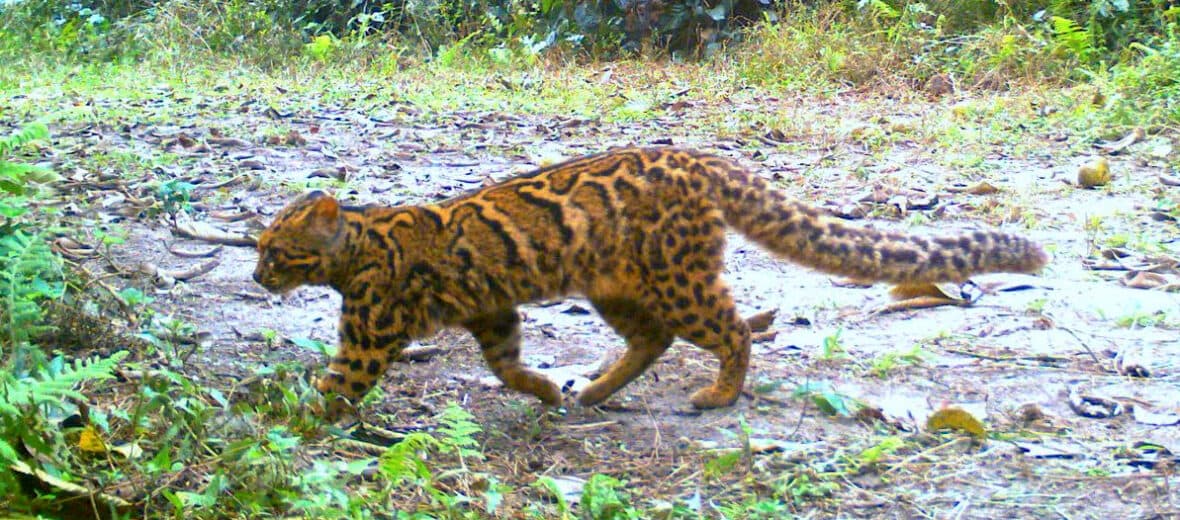
Here we have another small wild cat that has a very distinctive and interesting appearance. Marbled cat (ខ្លាភ្ញីថ្មកែវ) has a similar size to a domestic cat, growing from 45 to 62 centimeters. These felines have rounded ears and a very long tail that is as long as their head and body combined. The color of marbled cats varies from brownish-gray to ochreous brown along with black stripes on their head, neck, and back. The dark blotches on their bodies make them look like small clouded leopards, except theirs have marbling patterns. Marbled cats have thick and soft fur, and their bushy tail is very long sometimes it exceeds the head and body length.
As for the habitats, they associate with evergreen bamboo mixed forests, mixed conifer forests, and mixed deciduous-evergreen and moist tropical forests. At the same time, they also live in mixed swamp forests and peat swamp forests as well. Where they live, they feed on birds, reptiles, and rodents.
Some of the main threats to their population are indiscriminate snaring and deforestation for human settlements and plantations. People also hunt them for bones, meat, and skin to use for eating, commercial purposes, and medicine.
Tiger
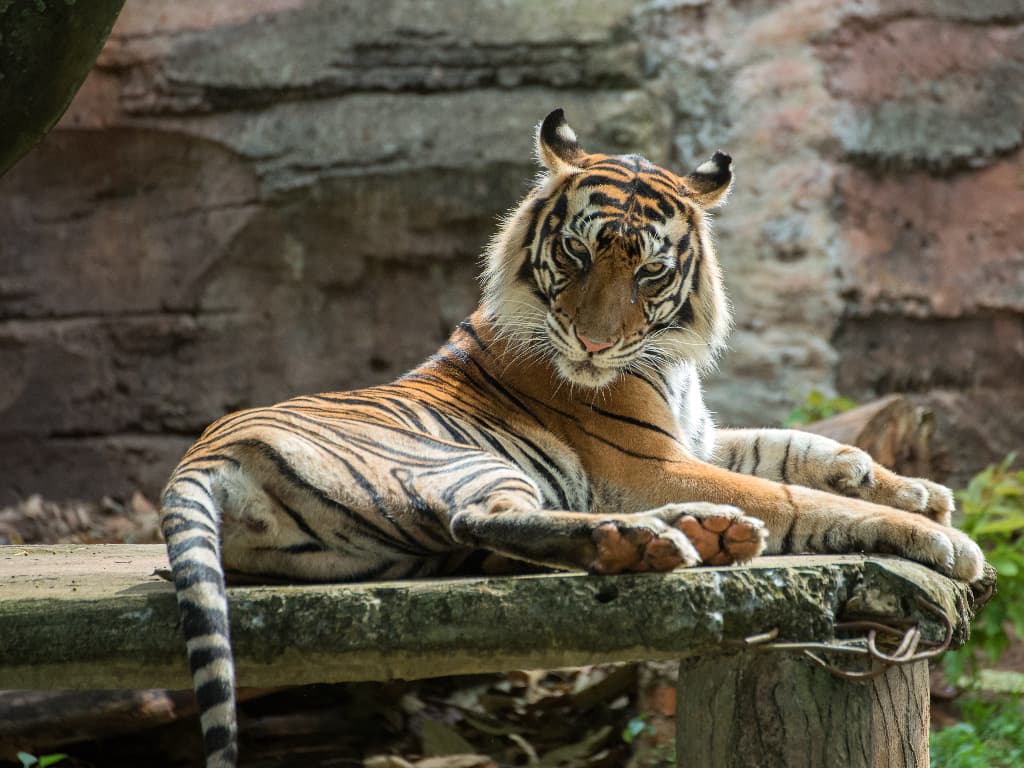
Sadly, tigers (ខ្លាធំ/ខ្លាដំបង) were functionally extinct in Cambodia since 2016. A year later, WWF reintroduced this big wild cat to the country again in 2017. This reintroduction is to bring back the population of tigers to the country but it is not the only solution. The thing is that wild tigers are still at risk globally due to many reasons. From habitat destruction to hunting, the population of wild tigers decreases every year. At the same time, they also need large territories to breed and hunt so things haven’t been good for them.
Tigers are majestic felines with so many fascinating features that many of us don’t know about. Everybody knows what a tiger looks like, but what about the details? Just a quick review, a tiger has a reddish-orange coat with dark stripes. As the largest wild cat in the world, a tiger can grow up to a meter tall, weighing up to 363 kilograms. Tigers have soft toe pads that allow them to walk silently through their habitats, benefiting their hunting.
As opportunistic predators, tigers prey on a wide range of animals including amphibians, birds, fish, reptiles, and rodents. Their favorite meals are antelope, deer, and wild boars but they also eat insects sometimes. Tigers are solitary so they hunt alone, and they do it at night. While lions eat their prey at the kill site, tigers don’t do that. They prefer to drag their prey into a cover to feed. In case it needs to drink water, it will cover the carcass by raking dirt, grass, leaves, and even rocks. One hunt can last a tiger for up to a few days to finish so the cover prevents scavengers from stealing the leftovers.
Fun Tiger Facts
- A group of a tiger or a tigress with her cubs is called an “ambush”.
- Tigers can’t purr so they close their eyes to indicate calmness or contentment.
- Wild tigers rarely roar but when they do, it can be heard from 3 kilometers away.
- A punch from a tiger’s front paw is enough to kill a person or at least break their bones.
- Tigers have antiseptic saliva so they can prevent injections by just licking their wounds.
- These wild cats have long and powerful paws with claws that can grow up to 12 centimeters.
- Tigers enjoy spending time in the water, and they love to swim for hours and several kilometers.
- Mother tigers take care of their cubs until they reach independence. This is why sometimes adult males would eat tiger cubs so that the tigress could be available for mating again.
- Their jaws and teeth are so powerful that can munch through bones, meat, and sinew easily. At the same time, their teeth are so sharp they can snap necks and kill prey in one bite.
- The stripes on a tiger are not only on their fur but also on their skin. These stripes are like our fingerprints as they act like the identity of each individual tiger. With that being said, no two tigers share the same stripes.
Related Post: Dangerous Venomous Snakes In Cambodia
